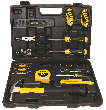Have you ever heard of a pipe diverter before? Chances are fairly good that if you are relatively new to the whole home plumbing scene, you probably don't know what this piece of equipment is, what it is used for, and other pertinent information. Keep reading to find out not only what is a pipe diverter, but some other rather useful information about this piece of equipment as well.
- What. In the simplest possible terms, a pipe diverter is exactly what it sounds like. A piece of plumbing equipment that is utilized to divert the flow of water from one particular pipe to another. Diverters are also used to help join two pipes into one, where you want the water to come out of a single faucet.
- Where. Many times you will see find diverters in bathrooms and kitchens where you will find sinks, tubs, and showers. All of these items will have two separate pipes of water (one hot, one could) which lead to the faucet. The diverter will be used to join the two items into the single opening offered by the faucet.
- Variants. Not only are there pipe diverters that are used for interior plumbing, but also for external plumbing purposes. For example, you can find some that are used for your gutters, or even an exterior well. Basically, there are just about as many variants to the pipe diverter as there are purposes for pipes. Beyond the basic purpose, there are also a wide variety of materials each diverter can be made from.
- When to replace. As with most things in this world, pipe diverters will eventually fail and need to be replaced. The trick is to learn the symptoms that symbolize when a diverter pipe is about to fail. Perhaps the single best indicator of having a problematic pipe diverter is a low water pressure. This lowered water pressure will be focused near the problem area (i.e., the kitchen or bathroom specifically).
Now that you know a little more about pipe diverters, you can begin using them a little more effectively. Keep in mind that if you find yourself needing to make any repairs or replacements to problematic or damaged diverter pipes, you may need to do some serious repair work. While you can easily make the repairs yourself, depending on where the problem is you may also need to do a bit of demolition work on the walls to make the repairs to the pipes.
Author Bio
Lee Wyatt
Contributor of numerous Tips.Net articles, Lee Wyatt is quickly becoming a regular "Jack of all trades." He is currently an independent contractor specializing in writing and editing. Contact him today for all of your writing and editing needs! Click here to contact. Learn more about Lee...
Arranging a Room for Comfort
Are you having trouble getting comfortable in your own home? Perhaps the reason for this is that your home simply isn't ...
Discover More
Keeping Driveways Maintained
A driveway is more than something to make your home look pretty. Since your driveway is also an investment, this means ...
Discover More
Replacing a Cracked Windshield
While you can repair most windshield cracks, why not take the opportunity to replace it with something a little better? ...
Discover More
More Home Improvement Tips
Fixing Leaky Pipes
Fixing minor pipe leaks is not a labor-intensive chore. The worst part of the job may be that you have to fit into tight ...
Discover More
Installing a Shower
Installing a shower is a great way to not only increase the property value of your home, but give you more options for ...
Discover More
Dealing with High Water Pressure
Despite what many people may like to think, there is such a thing as too much of a good thing. This is absolutely no ...
Discover More

Comments